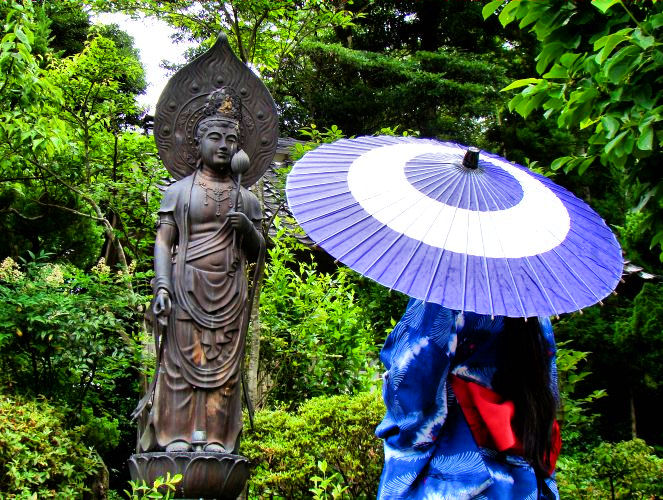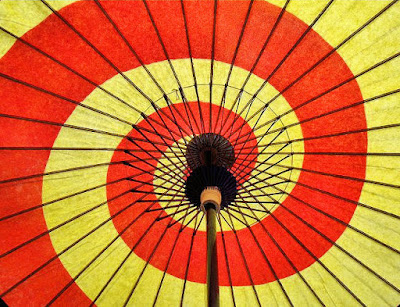Japanese Umbrellas bangasa & janomegasa
Japanese Umbrellas
Japanese Umbrellas
One of the most colorful and appealing images of traditional Japan is the graceful paper umbrella. Forty years ago there were almost 10,000 artisans in Japan making umbrellas of oiled paper and bamboo; now very few remain.
A few years ago Jacqueline Ruyak interviewed Shigeta Zenji, an umbrella maker from Obama in Fukui Prefecture. "I'm working for my health," laughed Shigeta. "I thought about retiring when I turned eighty-three, but I start to feel all my aches and pains if I don't work." A native of Obama, Shigeta says that he never wanted to make umbrellas. Being the oldest son, however, he had no choice but to follow in his father's footsteps. He used some tools his father made. "I always used to envy salaried workers because of their steady incomes, but I guess you could say my work is now my hobby. Now I have the time to enjoy both working and talking with customers."
Hard times hide in those words. In the 1950's, when the market for traditional umbrellas all but disappeared, Shigeta watched as the number of active umbrella makers dwindled, forced into retirement or another line of work. "It was hard, but I see it now as a kind of spiritual training. I couldn't have made it, though, without the support of my family. When I was at my peak, competition was fierce among the local makers as well as among makers in the rest of the country. That's all over now and I can take it easy, which is good at my age, I suppose. But I sometimes miss the stimulation." Shigeta is unusual among umbrella makers in that he made both the plain, sturdy bangasa and the colorful, slimmer and more elegant janomegasa.
The name bangasa evolved during the Edo period, when shopkeepers in Edo (present-day Tokyo) made it a practice to put a number (ban) on the umbrellas (kasa) they lent to customers caught in the rain. Janomegasa get their name from the umbrella's 'snake eye' design of concentric circles. Bangasa were so common before World War II that each prefecture had its own color combination, and umbrella makers had to be careful not to confuse orders from different parts of the country. Nowadays, most customers at Shigeta's sparsely furnished, tranquil shop buy the handmade umbrellas for nostalgic reasons or to use when wearing kimono, and janome are more popular. Because bamboo and washi (handmade paper) are essential for making Japanese umbrellas, artisans traditionally lived near a good source of both. Obama, in the Wakasa area of Fukui, is blessed with both abundant bamboo stands and Wakasa washi, and it used to be famous for its umbrellas. About 200,000 umbrellas a year were shipped to the Tohoku region and Hokkaido, Shigeta recalls. Those from Gifu, often called the home of the Japanese umbrella, were usually sent to Kyoto. The making of umbrella parts is still a cottage industry, and Shigeta used to order his ribs, nubs, and shanks from Gifu. Pointing to a pile of slender bamboo ribs, he sighed, "Next year they want a thirty percent increase for those, but I can't raise my prices." Shigeta favors the locally made washi for its strength. In addition to plain and colored paper, he uses a paper patterned with Japanese umbrellas, a design which is peculiar to Wakasa washi.
Twelve steps go into making an umbrella. First, the handle is attached to the nub, then the ribs, notched with holes, are fitted into slots in the nub. Once the ribs are in place they must be threaded together with strong cotton thread. Next, the ribs are spread apart and the holes at the ends are threaded together before a strip of paper, folded double, is pasted along what will become the rim of the umbrella. The fifth, and most important, step is fitting paper around the top so that rain cannot seep in. That done, strips of paper cut on the diagonal are pasted to every three ribs to give the umbrella a nicely rounded shape when furled. The umbrella is then dampened and left overnight. The next day, the ribs are painted with a mixture of paint and a red paste called benigara, and the paper is oiled with linseed oil. Next the umbrella is dried in the sun, then lacquered. How long does this process take? "That's hard to say because I usually work on fifty umbrellas at a time," says Shigeta, who adds that he was considered a full-fledged maker when he was able to finish one hundred umbrellas a month. To dry the umbrellas Shigeta takes them to a flat area, opens them, and sticks the handles in the ground---the best way to secure them, he says. A field of sunning umbrellas is a lovely image, but the capricious weather on the Japan Sea coast makes this the worst part of the process. "Around noon it starts raining or a wind comes up or the wind direction suddenly changes. Now I dry twenty to fifty umbrellas at a time, but when I was at my peak it was over two hundred. Getting them out of the ground in a sudden rainstorm was hard work, but at least I could dry any that got wet.
The wind is the problem. It tilts them one way, then another, and sometimes the gusts are enough to blow them into telephone wires or trees. Out of a hundred umbrellas, five or six are beyond repair." What is the best thing about using a bangasa or janome? The smooth yet warm feel of the bamboo handle? The sound of rain on the taut paper? The slight smell of lacquer and oil? The soft color of light filtered through paper? That two can fit cosily under one and be sure of staying dry? Used with care, a bangasa or janome should last for about ten years. Use is essential because the paper gets stronger each time it is softened by rain and allowed to dry. Shigeta advises using the umbrella as often as possible, then making sure that it dries thoroughly. Store it in a well-ventilated place to avoid ruining the oiling. With these few simple precautions, a traditional Japanese umbrella should be a thing of beauty and use for years. Jacqueline Ruyak The Japan Sea-coast town of Obama, where Shigeta Zenji lived, is about a three-hour train ride north from Kyoto Station. However, bangasa and janome can be purchased in Kyoto at the following shop: Tsujikura. Tsujikura is on the east side of Kawaramachi, north of Shijo. Open 11 am-7 pm, closed Wednesdays. Tsujikura 7F Tsujikura Bldg Higashi-gawa Shijyo Noboru Kawaramachi-dori Nakagyo-ku Kyoto 604-8026 Tel: 075 221 4396













